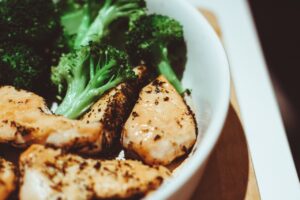Nutrition for Injury Recovery
Injuries are, unfortunately, all too common and an unavoidable fact of participating in sport and everyday life.
Less commonly understood, is the importance of good nutrition in the healing process. Most are aware of the importance of sport medicine and physiotherapy for recovery, but nutrition is another important pillar.
Energy
A common mistake is thinking of food as just calories, without considering the building blocks our bodies need. For example, many athletes decrease food intake immediately after an injury in fear of weight gain or body composition changes.
This concern is well founded: if you exercise less due to an injury, you should logically require less energy or calories than was once used to fuel your exercise. However, what is not as commonly realized, is that the healing process also requires energy.
The more severe the injury, the more energy the body will require to heal.
The majority of our body’s energy needs are for basic life-sustaining functions such as breathing, circulation, and cell production. So, although you are burning less energy due to decreased movement during an injury, your energy needs are more than just your basal metabolic rate. If ambulatory assistance tools such as crutches are required, energy expenditure increases drastically. This doesn’t mean that during an injury is the time to eat indiscriminately.

Rather than thinking of food as calories or energy alone, we must consider what building blocks are needed to repair the injury.
Our energy intake generally comes from three macronutrients: carbohydrates, protein, and fat and your body’s needs fluctuate depending on activity type and time, stage of life, medical conditions, illness, and injury. If we start thinking of food as the building blocks for our body, we can start to realize that we may need to provide it with different building blocks depending on the type of injury.
For example, imagine that a trail runner, whose diet is generally high in carbohydrates to support a high running demand, is now running very little due to a significant soft tissue injury. Their carbohydrate needs will decrease as the running demand has decreased, however, protein needs will increase to prevent lean muscle loss related to immobility and to repair the injured tissue.
Protein
Have you ever broken a bone and noticed drastic muscle loss related to immobility or heard the phrase “if you don’t use it, you lose it”?
Your sport medicine doctor, orthopedic surgeon, and physiotherapist have likely discussed the fine balance of immobility when needed for recovery, but then getting you back to some form of movement to reduce the risk of muscle loss and much more.
After a soft tissue injury, amino acid uptake accelerates to support the healing of wounds and tissues such as muscles, ligaments and tendons. If the demand is not met by diet, the body will meet this by breaking down skeletal muscle.

The more immobilized you are from your injury, the higher your protein needs become to prevent this muscle loss. However, increasing protein, without being deliberate about the type of protein, can also lead to unwanted weight gain as many protein-rich foods also contain high amounts of fats and therefore, energy.
This means choosing lean proteins like poultry, eggs, dairy, vegetarian sources like nuts, seeds, tofu, tempeh, edamame, beans, and lentils. Another great source is fish, which I will mention again later. If you eat vegetarian, aim for a variety of good quality protein foods like tofu, tempeh, beans, lentils, etc. Aim for each meal to have an excellent protein source (e.g. meat) and snacks including nuts, seeds, cheese, etc. Spread protein across the day rather than getting it all at one meal.
Calcium
Most of our body’s calcium is stored in our bones and help keep them strong. A small amount of calcium circulates in our blood.
If we don’t eat enough calcium from our diet, the body will pull calcium from our bones to maintain a predetermined blood calcium level.

During a bone related injury, adequate dietary calcium is even more important to ensure the body has the ingredients needed to rebuild the bone rather than pulling it from other bones.
Calcium-rich foods include yogurt, milk, cheese, leafy green vegetables (spinach, kale, collard greens), bok choy, broccoli, etc.
A great list of calcium-rich foods can be found at on the Osteoporosis Canada website.
Vitamin D
Vitamin D is one of those rare cases where supplementation is generally recommended, especially in the winter months in Canada.
Vitamin D is important for proper bone growth and healing as it aids in calcium absorption and reduces bone breakdown.
It is challenging to get enough vitamin D from natural dietary sources. We do make vitamin D when UVB rays from the sun touch our skin in the summer months, however, in the winter, the sun is not strong enough to make enough vitamin D to meet our needs. In fact, the likelihood of low vitamin D doubles in the winter according to Statistics Canada.
A great list of vitamin D sources can be found on the National Institute of Health website.
Preventing Nutritional Deficiencies during Recovery
Numerous micronutrients are involved in the healing process to a complexity which cannot be described in the context of this short article.
Inadequate micronutrient intake delays recovery time from injuries. Zinc, vitamin A, and vitamin C are directly involved in wound healing and skin integrity. Vitamin C, vitamin E and omega-3 fatty acids help reduce inflammation. Eating a balanced diet rich in whole grains (quinoa, bulgur, barley, oats, etc.), high in fruits and vegetables, lean protein, and fatty fish (salmon, herring, trout, mackerel, sardines), can ensure you meet these needs.
A diet-first approach is recommended so all the benefits of the food are gained. Nutrition research often finds that many micronutrients are more beneficial when the whole food is consumed, rather than supplementing. Take anti-inflammatories for example: the inflammatory response from an injury triggers the body to start healing. Taking high dose anti-inflammatory supplements may be counter-productive to this process. However, eating a diet high in anti-inflammatory foods will not only have an anti-inflammatory effect, it will also provide the micronutrients required to assist in healing.

If increasing a vitamin or mineral is indicated, first consider eating more of a food high in that compound rather than supplementing. This will get you all the other benefits of these foods such as other vitamins, minerals, phytochemicals, fibre, etc. If you have any concerns that you have a nutrient deficiency, please speak with your doctor and dietitian to determine the right path forward.
Lastly, limit things that may impair wound healing such as alcohol and smoking. Moderate consumption of alcohol is generally not going to have a meaningful impact; however, excess consumption of alcohol can impair wound healing.
Be intentional about your nutrition and remember…
…food holds the building blocks for healing and getting you back to the activities you enjoy.
To help optimize your recovery time and minimize negative impacts such as muscle loss, please consult a dietitian to ensure your nutrient needs are being met for your particular circumstances.
Expert Contributor

Lindsay Haager, BSc, RD, CDE, IOC Diploma in Sports Nutrition
Dietitian at Banff Sport Medicine







